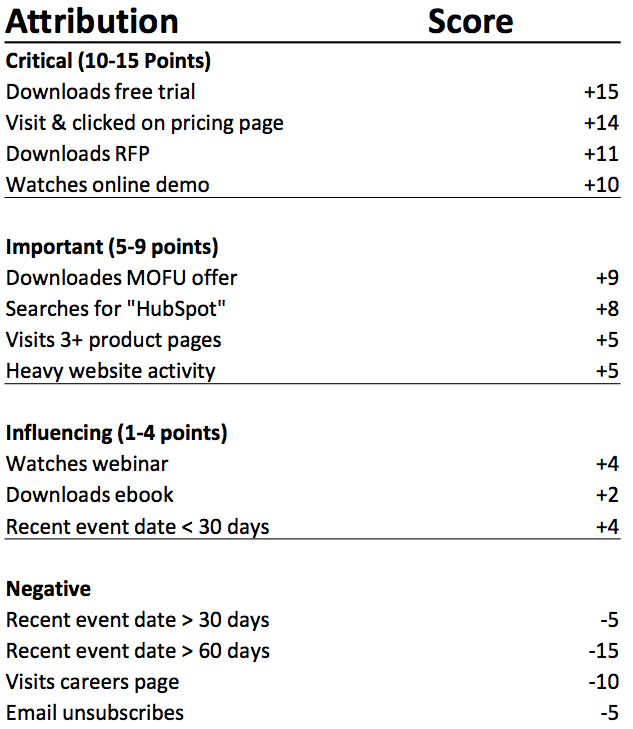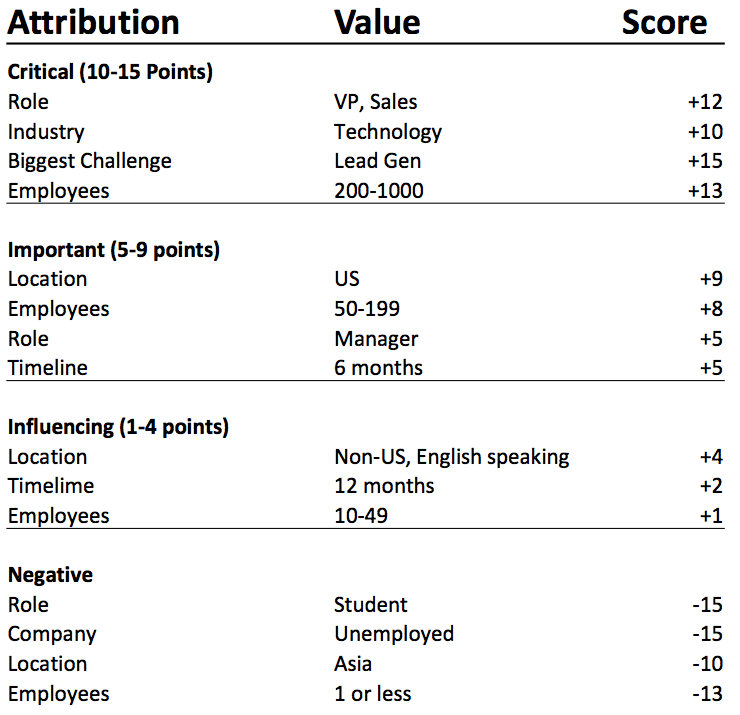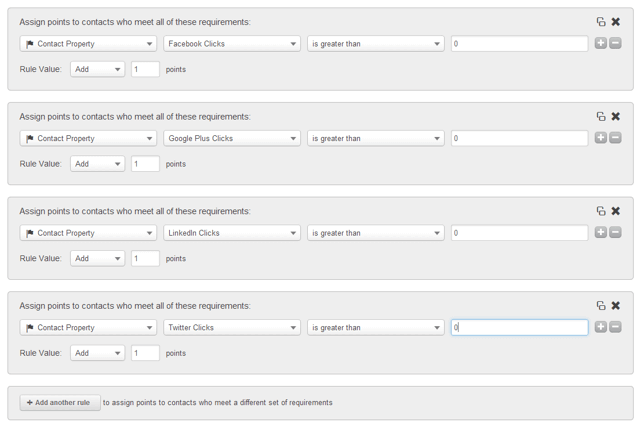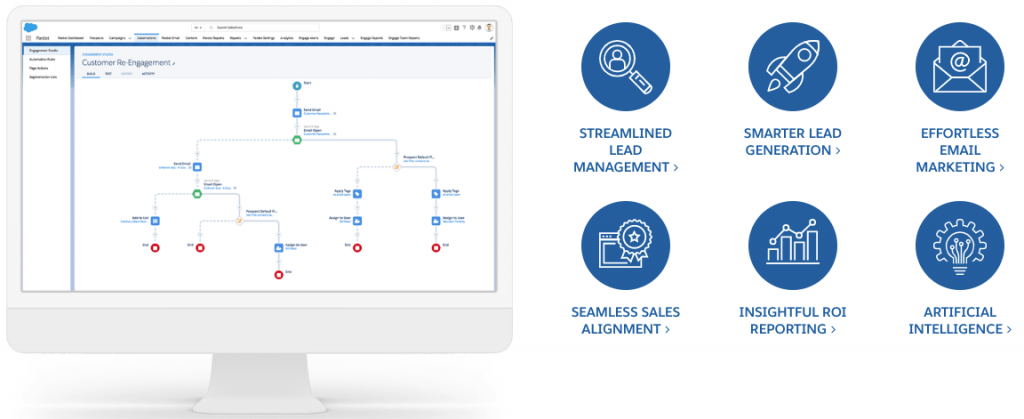Generating leads is one of the most difficult and frustrating challenges for any sales team. And once they generate the leads, SDRs face a new dilemma: how to prioritize them? In a perfect world, SDRs would instinctively know which leads were the most qualified, the most in need of the product, and the most ready to buy. But in reality, this isn’t the case. Left to their own devices, SDRs will use their past experiences with prospects to guide their decision making process.
So how do we prevent this fragmentation and have an accurate way to assess which leads are, in fact, the best? Enter lead scoring.
Lead scoring provides an objective and measurable framework for sorting leads, eliminating the confusion of trying to manually sort leads based on an individual rep’s experience and biases. Lead scoring will help your SDRs prioritize their leads, maximize their productivity, and ultimately boost your revenue.
What is lead scoring, anyway?
Essentially, lead scoring is the process of numerically ranking incoming leads on a scale that shows their potential to translate into sales.
This process involves assigning values to different behaviors so you can rank their potential interest in your product. Behaviors like visiting pricing pages, opening emails, and engaging with content would all indicate buying behavior and would raise the lead score. Some behaviors would score higher than others. For instance, a demo request would rank higher than downloading a white paper. The higher a prospect’s score, the higher the level of their potential interest.

(Source: Hubspot)
What is the difference between lead scoring and lead grading?
Lead scoring and grading are both used to qualify leads and can be powerful when used together. But what’s the difference between the two? Lead scoring is about which leads are most interested, while lead grading deals with which leads match your ideal customer profile.
When scoring leads, you assign a numerical value to note how interested they are in your product or service. You determine this by assigning values to implicit characteristics (interest in your product) – actions like registering for a webinar, requesting a demo, visiting the pricing page, etc. In lead grading, you give leads a letter grade between A-F based on explicit characteristics such as job title, industry, location, revenue and company size. Both are valuable ways to prioritize leads, especially when used together. Optimizing and enriching your data will give you the most accurate and detailed portrait possible of your prospect.

(Source: Hubspot)
Does lead scoring work? Benefits of lead scoring
Lead scores give SDRs a holistic view of their entire prospect list, with a number of data points that would be tedious, if not impossible, to uncover manually. With lead scoring, all of these data points get tracked and updated in real time, providing instant clarity on what leads to prioritize and what leads to leave on the back burner.
This prioritization not only boosts productivity, but also profit. In fact, 68% of marketers cite lead scoring as a primary contributor to driving revenue.
Lead scoring also simplifies the sales forecasting process, providing a clear picture of SDRs pipelines and what lead flow is necessary to achieve that month’s goals.
Automating your lead prioritization process will shorten your sales cycle. By giving SDRs key information, they can tailor their sales presentations for maximum impact and avoid wasting time talking about things the prospect isn’t interested in.
Your marketing team will receive important data, as well. By knowing the exact factors that define your hottest prospects, they can tailor their campaigns to drive more of the best leads to your SDRs. A Marketing Sherpa study showed 77% increase in lead generation ROI for teams using lead scoring.
Why is lead scoring difficult to implement?
The answer is sometimes due to a misalignment between the marketing and sales teams. If your marketing team is creating lead scores in a silo and using arbitrary data points based on assumptions, then the SDR’s skepticism is justifiable.
Your lead score needs to reflect your ideal customer profile and the actions they take during the buying process. What factors actually determine a prospect’s likelihood of becoming a customer?
Sometimes, it’s a lack of transparency from the marketing team that is causing the lack of buy-in. Giving the SDRs insight into what informs the lead scoring process, as well as listening to the sales team’s insights on trends they have noticed, will go a long way in establishing trust and increasing the likelihood that they’ll integrate the lead scores into their workflow.
Marketing vs. sales lead scoring
One reason for the misalignment between marketing and sales is the two different paradigms of what constitutes a scored lead.
“These leads have already been scored!” says the exasperated marketer. “But they haven’t been scored for me!” replies the frustrated sales rep. And the truth is, both the marketer and sales rep are correct.
As your marketing team begins generating leads at the top of the funnel, these marketing qualified leads (MQLs) will begin the nurturing process to become sales qualified leads (SQLs). And of course, MQLs will have their own scoring process.
For example, here is a lead scoring setup from Hubspot:

(Source: Hubspot)
However, knowing that an MQL has moved to SQL-status isn’t sufficient for a sales rep to make any informed decisions regarding the prioritization of the lead. All the SDR knows is that this lead has somehow become qualified for sales.
Your sales lead scoring needs to have additional qualifiers beyond the data of the MQL. And these need to reflect the reality of what your SDR will experience on a day-to-day basis. For example, your sales score might include the following:
Budget: Can they afford your product?
Authority: Is this the decision-maker?
Need: Does your product address a real pain point of the prospect?
Timing: Is your prospect able to buy now?
Then you would assign values to each of those factors.
How do you create a lead scoring system?
Although tools like Salesforce make the process as easy for the user as possible, there are certainly areas that you want to address to get the best out of your lead scoring experience. According to the Salesforce team, “You must decide the action that determines their shift from interest to intent.” The lead scores exist to empower the sales reps to do their job more effectively, so the first task will be to determine what moves a Marketing Qualified Lead (MQL) to a Sales Qualified Lead (SQL).
Here are some best practices to guide your lead scoring:
- Create separate lead scoring models for different products and services. For example, if you have an enterprise and SMB offerings, you would obviously have different criteria for each.
- Determine your lead scoring threshold. This is your make-or-break marker that moves your lead into sales-qualified territory.
- Categorize your high-value actions. What actions would a motivated buyer take? Visiting your contact page? Scrolling through the pricing page?
- Integrate lead scoring into your workflows. What happens at each scoring stage? An email, a phone call, a piece of direct mail? Both your marketing and sales teams should be connected in these workflows.
- Use negative scoring to filter out bad leads. Not all leads are equal. As time passes, the lead score should degrade if there hasn’t been any positive action. Also, determine what web pages are for non-buyers (like your careers page, for example).
Implementing Lead Scoring for Your Team with Salesforce
Since lead scoring is not a one-size-fits-all strategy, the first (and most important) step in the process is to have a clear picture of your ideal customer for all of your products or services and how they express their interest. Without a clear, data-driven understanding of what makes one lead better than another, your lead scoring will always be ineffective.
The next step is to map out what actions to take and when to take them throughout the buying cycle. Would a phone call be better than an email for first contact? How do you engage with prospects who are on your website? Again, there are no stock answers to these questions as the process will depend largely on your product offering and sales cycle. Fortunately, if you’re doing your lead scoring in Salesforce, Salesforce has two incredibly powerful tools to help with this process: Einstein and Pardot.
Einstein leverages machine learning to analyze all of your past closed deals to determine what factors are relevant for converting a prospect into a customer. Einstein will eliminate the guesswork of what your team believes is a perfect prospect and provide you with actionable insights for prioritizing leads.
Pardot provides powerful marketing automation to streamline the entire nurturing process. Not only can you set up automated followup workflows, you can also segment your audiences so that you are delivering the perfect message to each prospect. In addition to normal marketing campaigns, your SDRs can reach out with templated mini-campaigns for their prospects to save time and improve productivity.

(Source: Pardot.com)
Conclusion
At the end of the day, lead scoring can transform the workflow of your SDRs. Your team will convert more prospects, be more productive, and ultimately provide the best ROI possible. By aligning your sales and marketing teams from the outset, you can avoid inaccurate lead scoring that your reps will ignore and instead have a true data-driven scoring system. Leveraging Salesforce tools, such as Pardot and Einstein, will automate and streamline this process so that your SDRs can focus on what they do best: selling.
Looking for a SalesForce enrichment tool? Check out Lusha today.

